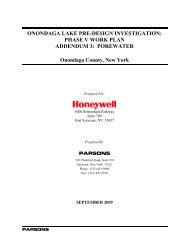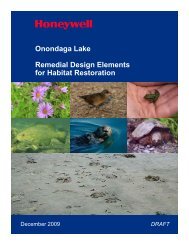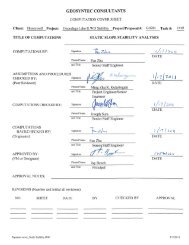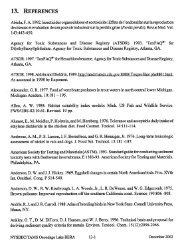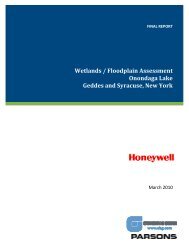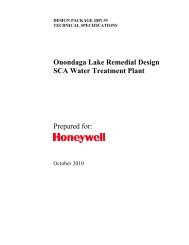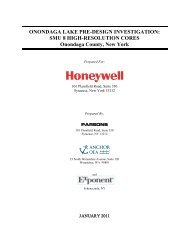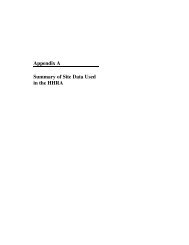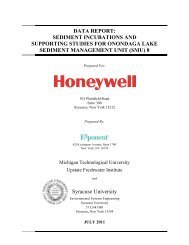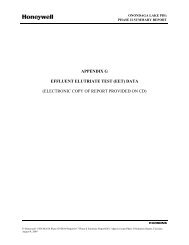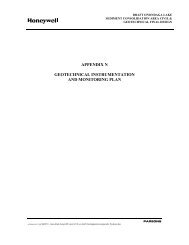Phase 1B Underwater Archaeological Report for the Onondaga ...
Phase 1B Underwater Archaeological Report for the Onondaga ...
Phase 1B Underwater Archaeological Report for the Onondaga ...
Create successful ePaper yourself
Turn your PDF publications into a flip-book with our unique Google optimized e-Paper software.
FINAL<br />
<strong>Phase</strong> IB <strong>Underwater</strong> <strong>Archaeological</strong> Resources <strong>Report</strong> <strong>for</strong> <strong>Onondaga</strong> Lake Superfund Site<br />
4. Simultaneous with 3 above, <strong>the</strong> locations of shallow water sonar anomalies were cross-referenced<br />
with those locations on Google Earth® and Microsoft® Virtual Earth to determine if <strong>the</strong>re were visible<br />
shoreline or shallow-water features that could identify <strong>the</strong> contact.<br />
5. Simultaneous to 3 and 4 above, historic navigational charts and maps were examined to determine if<br />
<strong>the</strong>re were charted historic features that could yield such an anomaly.<br />
6. The analysis resulting from steps 2-5 was recorded in tabular <strong>for</strong>m and in expanded <strong>for</strong>m and<br />
presented in <strong>the</strong> <strong>Underwater</strong> Work Plan.<br />
The <strong>Underwater</strong> Work Plan, in addition to outlining <strong>the</strong> locations of potential archaeological sites, also<br />
prescribed <strong>the</strong> tools and methods to be used <strong>for</strong> <strong>the</strong> <strong>Phase</strong> <strong>1B</strong> fieldwork.<br />
PHASE <strong>1B</strong> REMOTE SENSING METHODOLOGY<br />
The remote sensing fieldwork outlined in <strong>the</strong> <strong>Underwater</strong> Work Plan was executed from June 2 to 11,<br />
2010. The fieldwork was directed by LCMM, with CRE providing <strong>the</strong> survey vessel and captain, and <strong>the</strong><br />
remote sensing equipment and technician. The fieldwork was executed by Adam Kane (LCMM,<br />
<strong>Archaeological</strong> Director), Chip Ry<strong>the</strong>r (CRE, Oceanographic Operations Manager), Shipherd Densmore<br />
(CRE Survey Vessel Captain), Eli Perrone (CRE Oceanographic Technician), Bill Campbell (CRE ROV Pilot),<br />
and Christopher Wright (CRE Senior Hydrograpaher). Safety oversight was provided by Parsons through<br />
Dale Dolph, Kelly Miller and Xiaodong Huang.<br />
The following methodological approach was used to collect side scan sonar, scanning sonar and<br />
videographic data sets from each anomaly in or adjacent to a remediation area.<br />
Side Scan Sonar<br />
Side scan sonar data was acquired with an Edgetech Model 4125-P 400/1,250 kHz side scan sonar, and a<br />
Hemisphere VS-100 differential Global Positioning System (DPGS) and digital compass (Figure 24). The<br />
sonar and differential global positioning system (DGPS) were interfaced to a laptop computer running<br />
Edgetech Discover data acquisition software via E<strong>the</strong>rnet and serial connections, respectively.<br />
HYPACK hydrographic data acquisition and navigation software was used to design a series of survey<br />
transects centered on each anomaly. When possible, <strong>the</strong>se transects were extended to expedite<br />
insonification of nearby pairs or groups of anomalies. Transect spacing was set to 25 feet (7.6m) to<br />
accommodate <strong>the</strong> short ranges of <strong>the</strong> high frequency signals while ensuring approximately 200%<br />
coverage of each anomaly. A separate navigation computer was set up to provide a steering display <strong>for</strong><br />
<strong>the</strong> vessel pilot.<br />
The sonar towfish was deployed from <strong>the</strong> bow of CRE’s 26 foot (7.9m) survey vessel Lophius, using <strong>the</strong><br />
vessel’s A-frame and hydraulic winch (Figure 25). Because <strong>the</strong> majority of <strong>the</strong> anomalies were located in<br />
shallow water (less than 10-feet [3.1m] deep), a minimal length of tow cable was deployed. This short<br />
cable length was recorded to facilitate correction of offsets between <strong>the</strong> DGPS antenna and <strong>the</strong> towfish.<br />
Side scan sonar data were acquired using a 1,250 kHz signal. Sonar swath width settings (per channel)<br />
ranged from 33 to 82 feet (10 to 25m). Digital data were recorded in both Edgetech’s .JSF <strong>for</strong>mat and<br />
standard .XTF <strong>for</strong>mat. Data were archived to external hard drives at <strong>the</strong> end of each survey day.<br />
Navigation and data acquisition around many near-shore anomalies were hampered by dense aquatic<br />
vegetation. In some instances, this vegetation completely obscured data surrounding <strong>the</strong> anomaly.<br />
36



